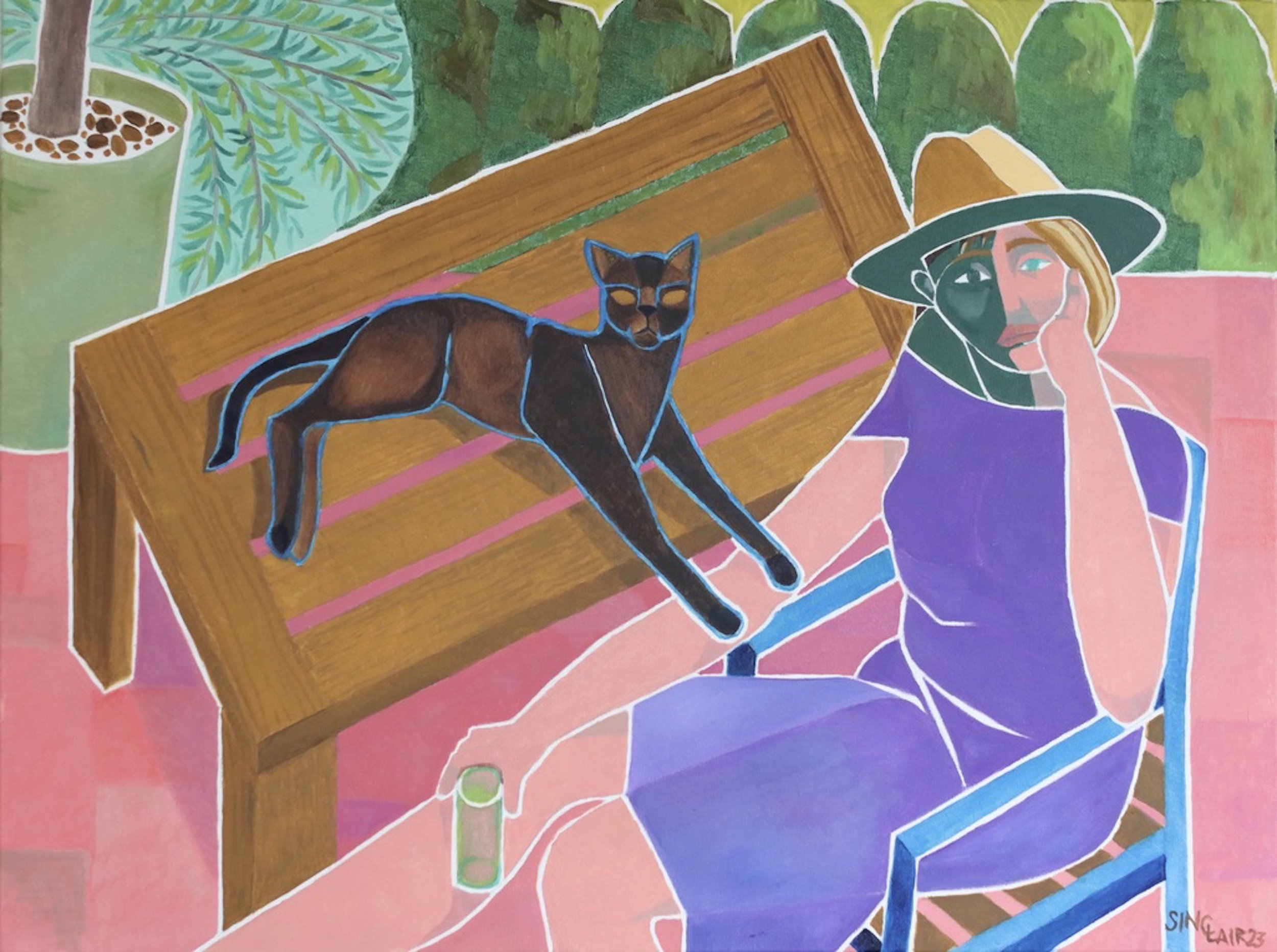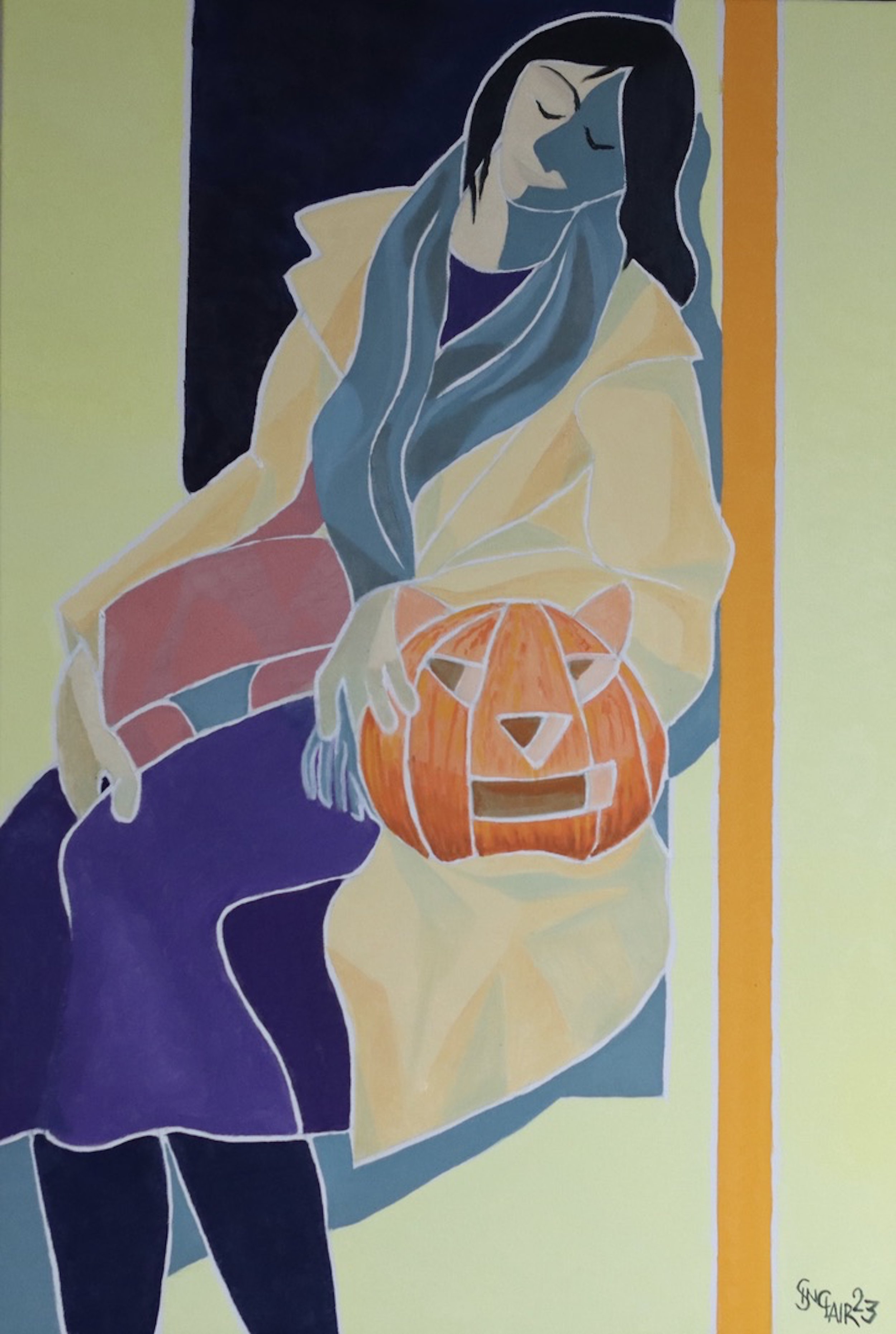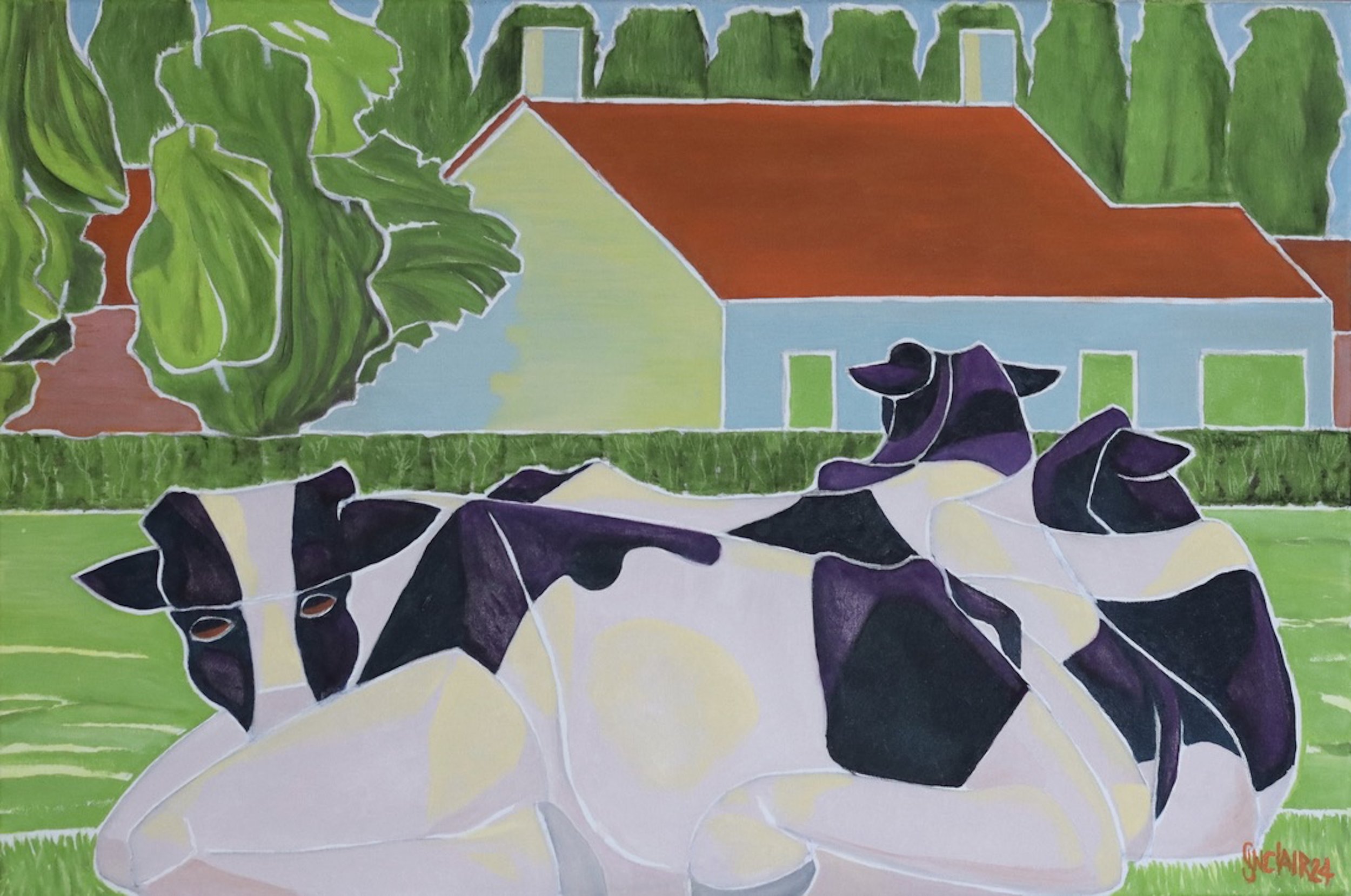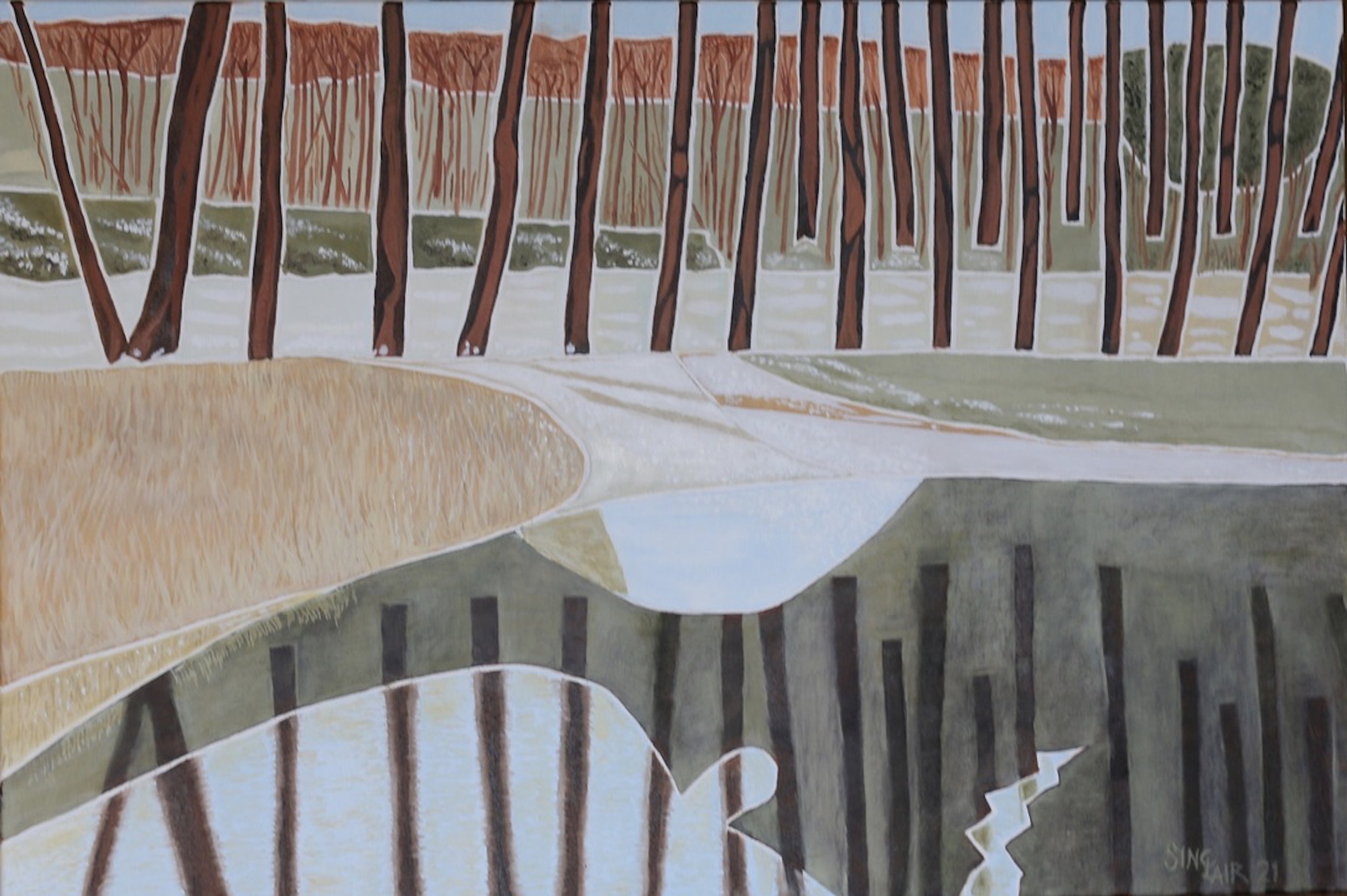Sinclair Webster
Sinclair Webster: Recollections in Tranquility – The Art of Memory and Archetype
Sinclair Webster’s paintings invite us to traverse the intimate corridors of memory, crafted not with the explicitness of photography but with the fleeting, half-recalled images of our own recollections. His art resonates like a gentle hum—a lingering whisper of moments not simply observed but absorbed, reconsidered, and re-imagined with a profound psychological depth. Webster’s assertion that his works come from a “rearview mirror…in my head” is an apt metaphor, evoking the sense that each painting is a recollection tempered by the passing of time, rendered in colors and forms that speak more to the memory of sensation than to factual representation. This dual act of remembering and reinterpreting transforms each painting into an experience that feels both personal and archetypal, a fusion that mirrors the creative impulse of poets like Wordsworth, who sought to capture “emotion recollected in tranquillity.”
Sinclair Webster’s art is a study in the poetry of recollection. His paintings operate within a language of memory, where the boundaries between reality and reminiscence blur. Webster’s deliberate choices in line and color, his attention to the interplay of shape and rhythm, and his approach to the canvas as a holistic field of equal treatment all contribute to an art that feels deeply authentic, resonating with the viewer on an almost unconscious level. By distilling his scenes to their essential forms, Sinclair Webster eliminates the superfluous and allows what remains to speak with a quiet power. His works are charismatic not in the sense of flamboyance, but in their ability to draw the viewer into a world where moments, whether grand or ordinary, are rendered with a significance that transcends time and place.
Sinclair Webster’s landscapes, particularly evident in works such as Chapel View and Green Lane, Surrey, echo with a sense of place that is simultaneously immediate and dreamlike. Here, the physical landscape merges with an interior one; the trees, hills, and buildings are real enough, but their arrangement speaks of a selective memory—a reshaping and re-assembly that makes them seem both familiar and surreal. His use of lines, stark yet fluid, demarcates these forms, offering a rhythmic quality that guides the viewer’s eye across the canvas. Each line becomes an architectural feature, an integral part of his memory-scape, bending and shifting as if influenced by the emotional weight of the scene itself. In Chapel View, the winding paths and softened edges appear like a topographical map of sentiment, the gentle rolling greens and interlocking shapes inviting viewers to wander through a pastoral dream.
In Ice on the Pond, Sinclair Webster masterfully manipulates reflection and symmetry, using the frozen surface of the water as both a literal mirror and a metaphorical one. Here, he reflects not only the surrounding trees but also the emotional resonance of this quiet scene—a winter memory, cool and contemplative, distilled to its essentials. The trees, rendered in vertical strokes, create a rhythmic forest of alternating shadows and reflections, visually echoing his idea that shapes and the “rhythms between them” are central to his artistic vision. Sinclair Webster’s restraint is notable here; he eliminates extraneous details, focusing instead on a reduced palette and a minimalist composition that allows the viewer to feel the silence of the frozen pond, the weight of the surrounding woods, and the patient stillness of nature in winter.
Yet Sinclair Webster is equally adept at capturing human intimacy, as seen in Sun Downers and Sitting in the Garden. Here, his palette brightens, and his forms become softer, almost tender in their simplification. The figures are outlined in broad, confident strokes, creating a sense of proximity and ease, as though the viewer has stumbled upon a private moment. In Sun Downers, the two figures are connected not just by their close physical proximity but by the shared hues that weave between them, blurring the boundary of individual identity. The subtle inclination of heads and arms speaks volumes about their relationship, revealing a nuanced understanding of body language. Similarly, in Sitting in the Garden, Sinclair Webster captures a figure lost in thought, accompanied by a cat who seems equally absorbed in the languid warmth of a sunlit afternoon. The simplicity of the setting—a chair, a table, a garden backdrop—places emphasis on the relaxed posture of the figure, the quiet companionship, and the sense of a memory cherished.
In works that feature animals, such as Chewing the Cud and Roe Rut Rusper, Sinclair Webster transcends mere depiction, transforming his subjects into symbols of tranquility and vitality. Chewing the Cud, with its lounging cows, invites us into a world of pastoral ease, where time slows, and each line and shade of green suggests the languor of a summer afternoon. The cows are stylized, almost geometric in form, yet this abstraction doesn’t detract from their life-like presence; rather, it elevates them to near archetypal figures of rural contentment. In Roe Rut Rusper, the fluid, elongated lines of the deer create a sense of graceful movement. The animals appear caught mid-gesture, and the viewer feels as though they are part of this woodland moment, breathing in the earthy scent of the forest floor, hearing the rustle of leaves beneath delicate hooves.
Sinclair Webster’s technique relies on a process that allows for transformation and conversation. As he describes, he often begins with quick sketches that capture the essence of a moment or scene, later translated onto commercially prepared canvases that introduce new dimensions and boundaries to his compositions. This process, which he describes as a kind of dialogue, allows each image to evolve organically. His approach to color and form is likewise organic; he applies large areas of flat color but skillfully grades and contrasts these hues to create texture and vibrancy, infusing his work with life and complexity. This choice transforms the canvas into a vibrant field where each area, each color, holds equal significance. His work treats the canvas not as a background but as a complete entity—a stage on which each shape, line, and shade plays a role in the overall composition.
One of the more poignant aspects of Sinclair Webster’s work is the way he captures the idea of memory through form and color. His palette is often limited to shades that feel both real and heightened, as though seen through the filter of nostalgia. The bold contrasts in pieces like Belgians, where warm skin tones play against cool backgrounds, emphasize the psychological depth of the figures, suggesting both presence and elusiveness. In London Overground, his muted tones and simplified lines turn the ordinary act of commuting into a contemplative scene, imbuing the figure with a quiet dignity. His figures do not strive for photographic likeness; rather, they aim to capture an essence, an emotional truth that is perhaps more authentic than realism itself.
The influence of Jungian archetypes and visual gestalts from Sinclair Webster’s early work remains palpable in his current style. His characters, whether human, animal, or even landscape elements, often resonate with archetypal significance. The trees in Beguinage, for instance, evoke a sense of community and quiet purpose. In Green Lane, Surrey, the landscape is no mere backdrop; it carries a weight of its own, embodying the archetype of a journey or a quest. The winding path, flanked by trees, invites the viewer into an almost mythic exploration of the English countryside, charged with both familiarity and mystery.
Sinclair Webster’s practice, as he has stated, is not one of immediate recording but of memory “recollected in tranquillity.” His paintings, then, are not mere reproductions of what he has seen; they are reconstructions, infused with a deeply personal vision. His art invites us to do more than just look; it asks us to remember, to reflect, and to see the world not just as it is, but as it lives within us. Through his art, Sinclair Webster offers us glimpses into a world viewed through the rearview mirror of memory, where each image, pared down to its essentials, speaks to a universal truth. In the end, Sinclair Webster’s greatness lies in his ability to transform the simple into the significant, turning everyday scenes into enduring symbols of human experience.
Belgians, 2024, oil paint on canvas, 90 X 60 cm.
London Overground, 2023, oil paint on canvas, 100 X 70 cm
Beguinage, 2023, oil paint on canvas, 76 X 61 cm
Green Lane, 2023, oil paint on canvas, 60 X 90 cm
Roe rut, Rusper, 2024, oil paint on canvas,100 X 100,
Sundowners, 2024, oil paint one canvas, 61 X 94 cm
Sitting in the garden with Alfie, 2023, oil paint on canvas, 76 X 102 cm
Chewing the cud, 2024, oil paint on canvas, 60 X 90 cm
Ice on the pond, 2022, oil paint on canvas, 60 X 90 cm
Chapel view,2020, oil paint on canvas, 60 X 80 cm












